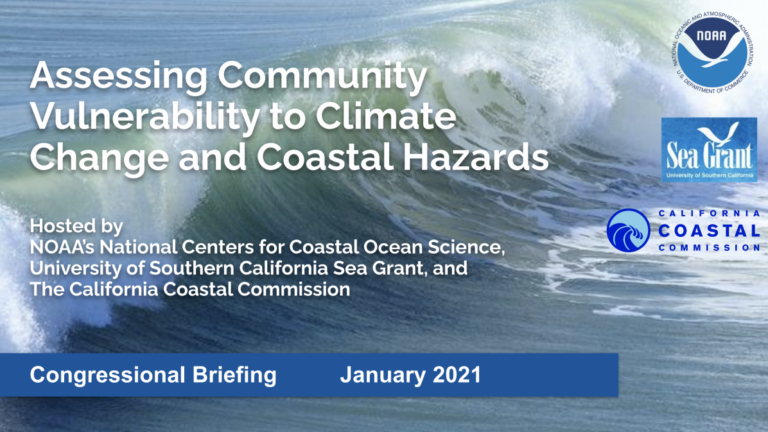
Climate Vulnerability Assessment Briefing
Earlier this month, a virtual congressional briefing was held on the assessment of climate vulnerability across the Los Angeles region. The event took place on Wednesday, January 13, 2021, and was co-hosted by NOAA, University of Southern California Sea Grant, and the California Coastal Commission.
NOAA is partnering with communities to identify and assess social, structural, and natural resource vulnerability profiles in relation to regional, place-based, climatic risks such as flooding, erosion, drought, heat, and wildfire. This briefing discussed NOAA’s integrated vulnerability assessment framework as applied in the Chesapeake Bay and Los Angeles County, exploring key findings and explaining how assessment results can be used by communities to prepare for climate change and coastal hazards.
Coastal communities and economies are increasingly vulnerable to coastal and climate-driven natural hazards. Social scientists with NOAA’s National Centers for Coastal Ocean Science (NCCOS) developed an integrated vulnerability assessment framework to identify and integrate climate vulnerabilities and risks of regional concern. In L.A. County, NOAA researchers also explored National Flood Insurance Policy claims, access to green and cultural space, and impacts of erosion and flooding on critical infrastructure and blufftop development within the 10-mile coastal band. These analyses found that many high flood risk areas have fewer flood insurance claims, at-risk populations and areas lack green space, cultural resources are at risk of flooding, disaster routes are susceptible to both flooding and erosion impacts, and many areas of new development share high erosion risk.
The framework provides a holistic first step in adaptation planning, and its final maps and underlying data can then be integrated into municipal sustainability or climate action plan development and implementation or used by community planners to identify priority geographies or intersections that warrant future investments of attention and adaptation funds.
The briefing included speakers from a range of federal, state, and local professionals across California further detailing the NCCOS project, as well as explaining the work on climate vulnerability assessments across Southern California. The presenters included:
- Chloe Fleming and Seann Regan, from NCCOS, presented the Climate Vulnerability Assessment project, the project approach, key findings, and what’s next.
- Rita Kampalath, from L.A. County’s Chief Sustainability Office, spoke about the current climate planning efforts of L.A. County.
- Sabrina Bornstein, from Buro Happold, shared about their social vulnerability assessment for West Hollywood.
- Michelle Jesperson, from the California Coastal Commission, presented the importance of science in building resilient communities.
Over 100 participants attended the event, including from multiple local, state, and federal partners, and representatives from several staffers of Congressional offices across the country, NOAA’s Appropriations Office, and authorizing Senate and House Committees.
Event Materials
- To view the powerpoint of the Climate Vulnerability Assessment Briefing, please click here.
Additional resources complementing the powerpoints are provided below:
- AdaptLA website
- Regional AdaptLA Full Report and Executive Summary
- LA County’s OurCounty Sustainability Plan
- NCCOS Project Page, Story Map, and Technical Report on the LA County Vulnerability Assessment
- California Coastal Commission’s website
- CCC’s Story Map on Sea Level Rise in California
- CCC’s Sea Level Rise Policy Guidance for Planning and Permitting


